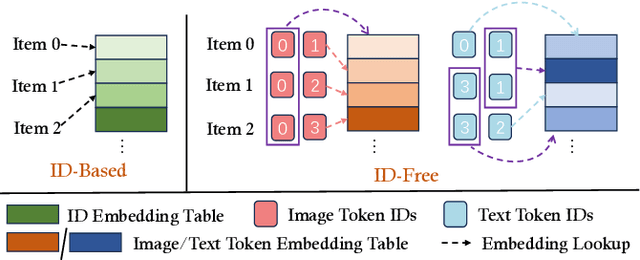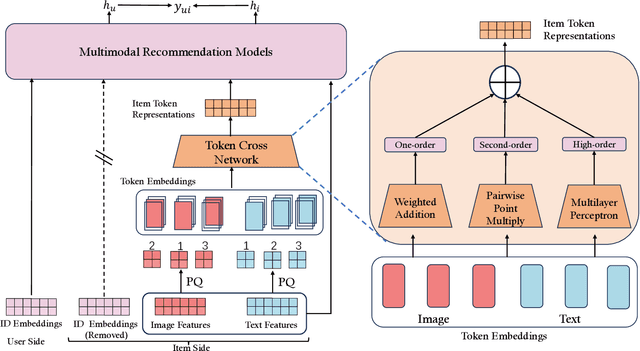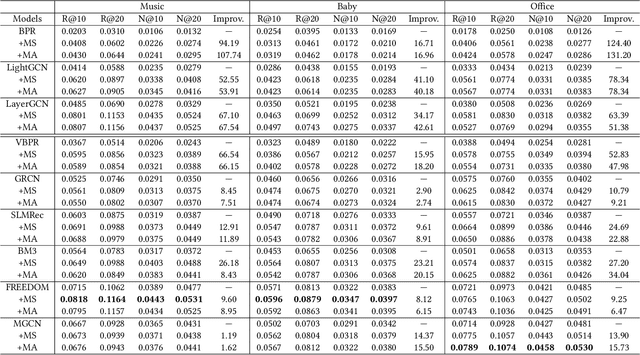Jiarui Jin
A Metric for MLLM Alignment in Large-scale Recommendation
Aug 07, 2025Abstract:Multimodal recommendation has emerged as a critical technique in modern recommender systems, leveraging content representations from advanced multimodal large language models (MLLMs). To ensure these representations are well-adapted, alignment with the recommender system is essential. However, evaluating the alignment of MLLMs for recommendation presents significant challenges due to three key issues: (1) static benchmarks are inaccurate because of the dynamism in real-world applications, (2) evaluations with online system, while accurate, are prohibitively expensive at scale, and (3) conventional metrics fail to provide actionable insights when learned representations underperform. To address these challenges, we propose the Leakage Impact Score (LIS), a novel metric for multimodal recommendation. Rather than directly assessing MLLMs, LIS efficiently measures the upper bound of preference data. We also share practical insights on deploying MLLMs with LIS in real-world scenarios. Online A/B tests on both Content Feed and Display Ads of Xiaohongshu's Explore Feed production demonstrate the effectiveness of our proposed method, showing significant improvements in user spent time and advertiser value.
Large Language Models are Demonstration Pre-Selectors for Themselves
Jun 06, 2025Abstract:In-context learning (ICL) with large language models (LLMs) delivers strong few-shot performance by choosing few-shot demonstrations from the entire training data. However, existing ICL methods, which rely on similarity or diversity scores to choose demonstrations, incur high computational costs due to repeatedly retrieval from large-scale datasets for each query. To this end, we propose FEEDER (FEw yet Essential Demonstration prE-selectoR), a novel pre-selection framework that identifies a representative subset of demonstrations containing the most representative examples in the training data, tailored to specific LLMs. To construct this subset, we introduce the "sufficiency" and "necessity" metrics in the pre-selection stage and design a tree-based algorithm to identify representative examples efficiently. Once pre-selected, this representative subset can effectively replace the full training data, improving efficiency while maintaining comparable performance in ICL. Additionally, our pre-selected subset also benefits fine-tuning LLMs, where we introduce a bi-level optimization method that enhances training efficiency without sacrificing performance. Experiments with LLMs ranging from 300M to 8B parameters show that FEEDER can reduce training data size by over 20% while maintaining performance and seamlessly integrating with various downstream demonstration selection strategies in ICL.
Why Not Together? A Multiple-Round Recommender System for Queries and Items
Dec 14, 2024



Abstract:A fundamental technique of recommender systems involves modeling user preferences, where queries and items are widely used as symbolic representations of user interests. Queries delineate user needs at an abstract level, providing a high-level description, whereas items operate on a more specific and concrete level, representing the granular facets of user preference. While practical, both query and item recommendations encounter the challenge of sparse user feedback. To this end, we propose a novel approach named Multiple-round Auto Guess-and-Update System (MAGUS) that capitalizes on the synergies between both types, allowing us to leverage both query and item information to form user interests. This integrated system introduces a recursive framework that could be applied to any recommendation method to exploit queries and items in historical interactions and to provide recommendations for both queries and items in each interaction round. Empirical results from testing 12 different recommendation methods demonstrate that integrating queries into item recommendations via MAGUS significantly enhances the efficiency, with which users can identify their preferred items during multiple-round interactions.
Learning ID-free Item Representation with Token Crossing for Multimodal Recommendation
Oct 25, 2024



Abstract:Current multimodal recommendation models have extensively explored the effective utilization of multimodal information; however, their reliance on ID embeddings remains a performance bottleneck. Even with the assistance of multimodal information, optimizing ID embeddings remains challenging for ID-based Multimodal Recommender when interaction data is sparse. Furthermore, the unique nature of item-specific ID embeddings hinders the information exchange among related items and the spatial requirement of ID embeddings increases with the scale of item. Based on these limitations, we propose an ID-free MultimOdal TOken Representation scheme named MOTOR that represents each item using learnable multimodal tokens and connects them through shared tokens. Specifically, we first employ product quantization to discretize each item's multimodal features (e.g., images, text) into discrete token IDs. We then interpret the token embeddings corresponding to these token IDs as implicit item features, introducing a new Token Cross Network to capture the implicit interaction patterns among these tokens. The resulting representations can replace the original ID embeddings and transform the original ID-based multimodal recommender into ID-free system, without introducing any additional loss design. MOTOR reduces the overall space requirements of these models, facilitating information interaction among related items, while also significantly enhancing the model's recommendation capability. Extensive experiments on nine mainstream models demonstrate the significant performance improvement achieved by MOTOR, highlighting its effectiveness in enhancing multimodal recommendation systems.
DRepMRec: A Dual Representation Learning Framework for Multimodal Recommendation
Apr 17, 2024



Abstract:Multimodal Recommendation focuses mainly on how to effectively integrate behavior and multimodal information in the recommendation task. Previous works suffer from two major issues. Firstly, the training process tightly couples the behavior module and multimodal module by jointly optimizing them using the sharing model parameters, which leads to suboptimal performance since behavior signals and modality signals often provide opposite guidance for the parameters updates. Secondly, previous approaches fail to take into account the significant distribution differences between behavior and modality when they attempt to fuse behavior and modality information. This resulted in a misalignment between the representations of behavior and modality. To address these challenges, in this paper, we propose a novel Dual Representation learning framework for Multimodal Recommendation called DRepMRec, which introduce separate dual lines for coupling problem and Behavior-Modal Alignment (BMA) for misalignment problem. Specifically, DRepMRec leverages two independent lines of representation learning to calculate behavior and modal representations. After obtaining separate behavior and modal representations, we design a Behavior-Modal Alignment Module (BMA) to align and fuse the dual representations to solve the misalignment problem. Furthermore, we integrate the BMA into other recommendation models, resulting in consistent performance improvements. To ensure dual representations maintain their semantic independence during alignment, we introduce Similarity-Supervised Signal (SSS) for representation learning. We conduct extensive experiments on three public datasets and our method achieves state-of-the-art (SOTA) results. The source code will be available upon acceptance.
An Aligning and Training Framework for Multimodal Recommendations
Mar 20, 2024



Abstract:With the development of multimedia applications, multimodal recommendations are playing an essential role, as they can leverage rich contexts beyond user interactions. Existing methods mainly regard multimodal information as an auxiliary, using them to help learn ID features; however, there exist semantic gaps among multimodal content features and ID features, for which directly using multimodal information as an auxiliary would lead to misalignment in representations of users and items. In this paper, we first systematically investigate the misalignment issue in multimodal recommendations, and propose a solution named AlignRec. In AlignRec, the recommendation objective is decomposed into three alignments, namely alignment within contents, alignment between content and categorical ID, and alignment between users and items. Each alignment is characterized by a specific objective function and is integrated into our multimodal recommendation framework. To effectively train our AlignRec, we propose starting from pre-training the first alignment to obtain unified multimodal features and subsequently training the following two alignments together with these features as input. As it is essential to analyze whether each multimodal feature helps in training, we design three new classes of metrics to evaluate intermediate performance. Our extensive experiments on three real-world datasets consistently verify the superiority of AlignRec compared to nine baselines. We also find that the multimodal features generated by AlignRec are better than currently used ones, which are to be open-sourced.
InfoRank: Unbiased Learning-to-Rank via Conditional Mutual Information Minimization
Jan 23, 2024



Abstract:Ranking items regarding individual user interests is a core technique of multiple downstream tasks such as recommender systems. Learning such a personalized ranker typically relies on the implicit feedback from users' past click-through behaviors. However, collected feedback is biased toward previously highly-ranked items and directly learning from it would result in a "rich-get-richer" phenomenon. In this paper, we propose a simple yet sufficient unbiased learning-to-rank paradigm named InfoRank that aims to simultaneously address both position and popularity biases. We begin by consolidating the impacts of those biases into a single observation factor, thereby providing a unified approach to addressing bias-related issues. Subsequently, we minimize the mutual information between the observation estimation and the relevance estimation conditioned on the input features. By doing so, our relevance estimation can be proved to be free of bias. To implement InfoRank, we first incorporate an attention mechanism to capture latent correlations within user-item features, thereby generating estimations of observation and relevance. We then introduce a regularization term, grounded in conditional mutual information, to promote conditional independence between relevance estimation and observation estimation. Experimental evaluations conducted across three extensive recommendation and search datasets reveal that InfoRank learns more precise and unbiased ranking strategies.
Lending Interaction Wings to Recommender Systems with Conversational Agents
Oct 06, 2023



Abstract:Recommender systems trained on offline historical user behaviors are embracing conversational techniques to online query user preference. Unlike prior conversational recommendation approaches that systemically combine conversational and recommender parts through a reinforcement learning framework, we propose CORE, a new offline-training and online-checking paradigm that bridges a COnversational agent and REcommender systems via a unified uncertainty minimization framework. It can benefit any recommendation platform in a plug-and-play style. Here, CORE treats a recommender system as an offline relevance score estimator to produce an estimated relevance score for each item; while a conversational agent is regarded as an online relevance score checker to check these estimated scores in each session. We define uncertainty as the summation of unchecked relevance scores. In this regard, the conversational agent acts to minimize uncertainty via querying either attributes or items. Based on the uncertainty minimization framework, we derive the expected certainty gain of querying each attribute and item, and develop a novel online decision tree algorithm to decide what to query at each turn. Experimental results on 8 industrial datasets show that CORE could be seamlessly employed on 9 popular recommendation approaches. We further demonstrate that our conversational agent could communicate as a human if empowered by a pre-trained large language model.
Replace Scoring with Arrangement: A Contextual Set-to-Arrangement Framework for Learning-to-Rank
Aug 05, 2023



Abstract:Learning-to-rank is a core technique in the top-N recommendation task, where an ideal ranker would be a mapping from an item set to an arrangement (a.k.a. permutation). Most existing solutions fall in the paradigm of probabilistic ranking principle (PRP), i.e., first score each item in the candidate set and then perform a sort operation to generate the top ranking list. However, these approaches neglect the contextual dependence among candidate items during individual scoring, and the sort operation is non-differentiable. To bypass the above issues, we propose Set-To-Arrangement Ranking (STARank), a new framework directly generates the permutations of the candidate items without the need for individually scoring and sort operations; and is end-to-end differentiable. As a result, STARank can operate when only the ground-truth permutations are accessible without requiring access to the ground-truth relevance scores for items. For this purpose, STARank first reads the candidate items in the context of the user browsing history, whose representations are fed into a Plackett-Luce module to arrange the given items into a list. To effectively utilize the given ground-truth permutations for supervising STARank, we leverage the internal consistency property of Plackett-Luce models to derive a computationally efficient list-wise loss. Experimental comparisons against 9 the state-of-the-art methods on 2 learning-to-rank benchmark datasets and 3 top-N real-world recommendation datasets demonstrate the superiority of STARank in terms of conventional ranking metrics. Notice that these ranking metrics do not consider the effects of the contextual dependence among the items in the list, we design a new family of simulation-based ranking metrics, where existing metrics can be regarded as special cases. STARank can consistently achieve better performance in terms of PBM and UBM simulation-based metrics.
Set-to-Sequence Ranking-based Concept-aware Learning Path Recommendation
Jun 07, 2023



Abstract:With the development of the online education system, personalized education recommendation has played an essential role. In this paper, we focus on developing path recommendation systems that aim to generating and recommending an entire learning path to the given user in each session. Noticing that existing approaches fail to consider the correlations of concepts in the path, we propose a novel framework named Set-to-Sequence Ranking-based Concept-aware Learning Path Recommendation (SRC), which formulates the recommendation task under a set-to-sequence paradigm. Specifically, we first design a concept-aware encoder module which can capture the correlations among the input learning concepts. The outputs are then fed into a decoder module that sequentially generates a path through an attention mechanism that handles correlations between the learning and target concepts. Our recommendation policy is optimized by policy gradient. In addition, we also introduce an auxiliary module based on knowledge tracing to enhance the model's stability by evaluating students' learning effects on learning concepts. We conduct extensive experiments on two real-world public datasets and one industrial dataset, and the experimental results demonstrate the superiority and effectiveness of SRC. Code will be available at https://gitee.com/mindspore/models/tree/master/research/recommend/SRC.
 Add to Chrome
Add to Chrome Add to Firefox
Add to Firefox Add to Edge
Add to Edge